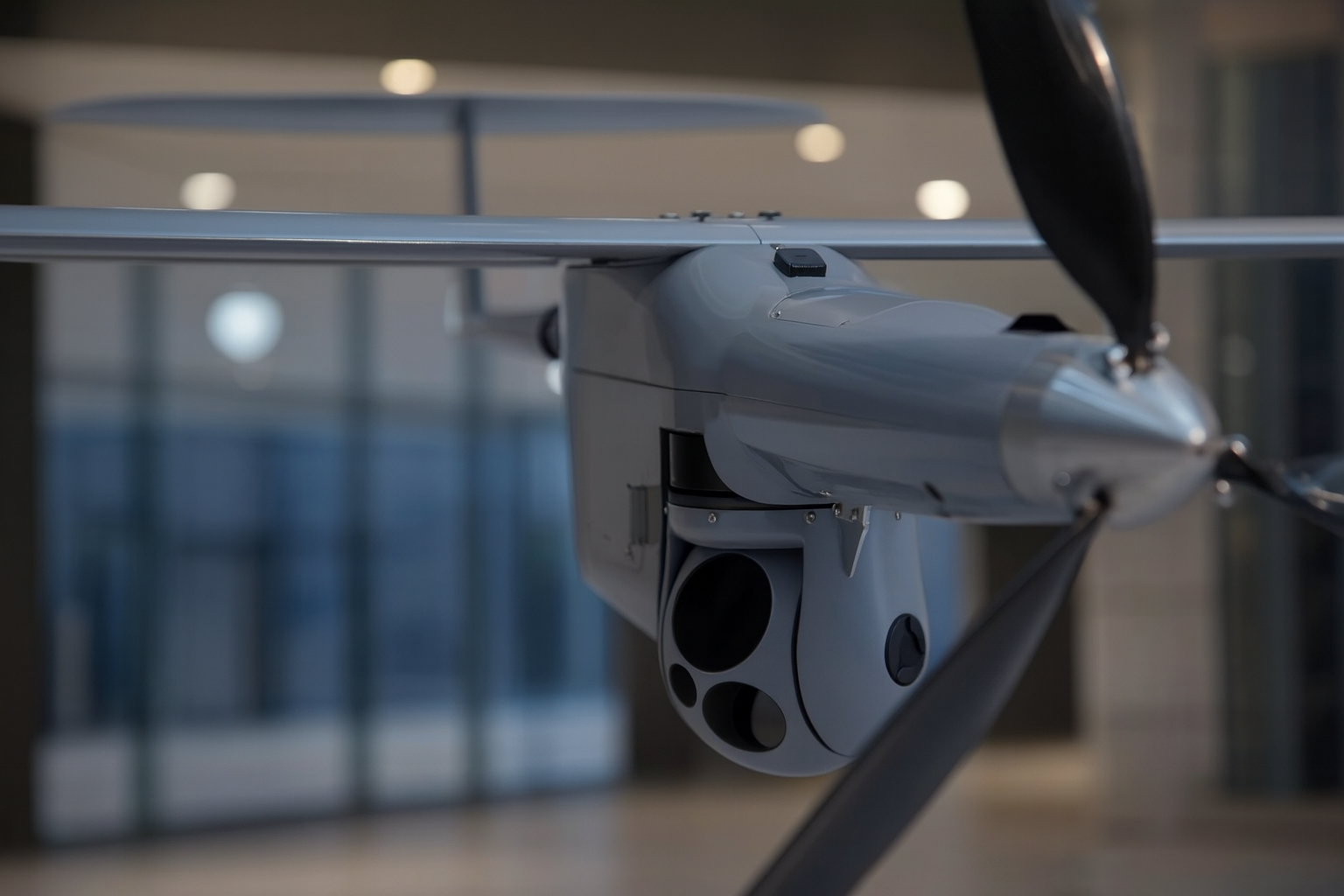- What it is: FlyEye is a hand‑launched, electric, close‑range ISR mini‑UAS (intelligence, surveillance and reconnaissance) designed by WB Group/Flytronic in Poland. Setup time is under 10 minutes and a two‑person team can carry it in backpacks. GRUPA WB
- Size & weight: Wingspan 3.6 m; length 1.8 m; MTOW 12 kg (earlier literature lists 11 kg). GRUPA WB
- Performance: Endurance 2.5 h+ (≈150 min), 60–120 km/h, ceiling 3,500 m AMSL (typical operations limited to ~1,000 m AGL). GRUPA WB
- Data link (LOS): Standard/high‑gain ground kit up to 50 km; mobile/tactical antennas ~10 km; WB Group’s product page also lists “online transmission range 180 km LOS” (extended configurations). GRUPA WB
- Sensors: Interchangeable EO/IR heads including GS3‑DL (30× day camera), GS3‑IR (thermal), GS4 (dual EO/IR with laser highlighter) and “Target Lock” video‑tracking. GRUPA WB
- Navigation & EW resilience: Works in GPS‑denied environments via odometric navigation; multi‑level safety (auto‑return, spin/stall recovery, speed‑sensor failure handling). GRUPA WB
- Launch & recovery: Hand‑launch; two‑phase landing—payload/battery pod descends by parachute; airframe performs autonomous landing. GRUPA WB
- Comms & security: C‑band uplink/downlink; AES‑CCM‑128 encryption; simultaneous remote video terminals supported. GRUPA WB
- Integrated fires: Natively integrated with Poland’s TOPAZ fire control / battlefield management system for rapid target coordinate handoff and artillery adjustment. European Security & Defence
- In service & production: Used by Poland and Ukraine (among others). Poland ordered 52 more systems in 2024; WB Group announced the 1,000th FlyEye produced in March 2024; production launched in Ukraine in 2025. Pravda
What is FlyEye and why it matters
FlyEye is a combat‑proven, electric mini‑UAS built for rapid, quiet reconnaissance in cluttered or contested environments. It’s been refined through intensive operational use (notably in Ukraine), where its quick deployment, low acoustic signature and robust datalinks have made it a staple for artillery spotting, route security and border surveillance. The manufacturer markets it as a modular, hand‑launched platform that’s ready to fly in under 10 minutes and designed for small teams. GRUPA WB
Airframe & propulsion
The airframe is a composite high‑aspect‑ratio motor‑glider layout optimized for efficient cruise on electric power. Current data sheets list MTOW 12 kg (earlier catalogs showed 11 kg), with wingspan 3.6 m and length 1.8 m. Propulsion is a silent electric engine powered by Li‑Po batteries, a choice that reduces thermal/acoustic signatures and simplifies logistics. GRUPA WB
Performance envelope
WB Group quotes 2.5 hours+ endurance, 60–120 km/h cruise/sprint, and a maximum altitude of 3,500 m AMSL; normal operations are often capped to about 1,000 m AGL for airspace/mission reasons. These figures align with manufacturer PDFs and reflect incremental improvements across FlyEye generations. GRUPA WB
Payloads & sensing
FlyEye’s gimballed EO/IR turrets are modular:
- GS3‑DL: full‑HD daylight sensor with 30× optical zoom and 2‑axis gyro‑stabilization plus digital stabilization.
- GS3‑IR: fixed‑lens thermal camera (8–14 µm).
- GS4: dual EO/IR core with a laser highlighter; payloads support Target Lock for persistent tracking and accurate coordinate generation. GRUPA WB
This mix lets operators search with IR, PID with optical zoom, and hand off coordinates to fires/C2 systems in real time. In Ukraine, units emphasize the 30× day zoom plus IR combo for day‑night continuity. Inside Unmanned Systems
Communications, control & security
FlyEye uses C‑band for both uplink and downlink with AES‑CCM‑128 encryption. Remote video terminals can subscribe simultaneously so multiple users (e.g., forward observers, command posts) see the feed. Antenna options include:
- Standard/Maritime high‑gain directional: ~50 km LOS
- Mobile/Tactical: ~10 km LOS, suitable for convoy escort mode
WB’s product page also lists “online transmission range 180 km LOS,” which reflects extended configurations and RF conditions—larger high‑gain systems and line‑of‑sight geometry can materially change reach. GRUPA WB
Autonomy, safety & EW resilience
FlyEye incorporates multi‑level safety and EW‑resilient navigation:
- Auto‑return triggers after a user‑defined comms‑loss timer (“Time to Return”).
- Spin/stall recovery and speed‑sensor failure handling keep the aircraft flyable in turbulence or icing of the pitot/Prandtl system.
- GPS‑denied operation: an odometric navigation subsystem estimates position using last known GPS, wind vectors, magnetic field, and other onboard data, allowing the mission to continue or divert to a pre‑planned landing. GRUPA WB
Launch, landing & fieldability
The aircraft is hand‑launched, streamlining operations in confined spaces (urban canyons, forest clearings). Recovery is two‑phase: the payload/battery module ejects and parachutes to protect the gimbal and cells, while the airframe performs a precise autonomous landing. A two‑person crew can carry the system in tactical backpacks and assemble it in under 10 minutes. GRUPA WB
Ground segment & software
A rugged Ground Control Station with Commander II software provides mission planning, flight‑plan edits on the fly, camera‑guided flight, “hold”, convoy escort, and out‑of‑range mission continuation (record locally, retrieve post‑flight). WB Group documents O/I/D‑level maintenance concepts and a two‑week training pipeline. GRUPA WB
Fire‑support integration (TOPAZ)
A standout feature is deep integration with Poland’s TOPAZ integrated combat/fire‑control system. That linkage streamlines sensor‑to‑shooter workflows—from coordinate generation to artillery fire adjustment—and is a major reason FlyEye is fused into Polish Rocket & Artillery Forces tactics. Independent write‑ups corroborate this integration. European Security & Defence
Variants and ecosystem
- FlyEye 3.x: the current family with improved comms, sensors (e.g., 30× zoom), and extended LOS options versus earlier generations (older specs listed 30 km LOS, newer docs cite 50 km, while the site lists 180 km for extended setups). GRUPA WB
- FlyEye MED: a derivative pitched for medical logistics and enforcement roles; Janes reported >50 km point‑to‑point deliveries within ~15 m drop accuracy. Default
- Compatibility: part of a broader WB ecosystem (e.g., TOPAZ, FONET, WARMATE loitering munition) intended for networked ISR‑to‑strike operations. GRUPA WB
Who uses it, and what’s new
- Poland: long‑time user; in Nov 2024 Poland signed for 52 FlyEye systems, underpinning a national push to expand drone forces. Reuters
- Ukraine: FlyEye has been in Ukrainian service since 2015 and widely employed for artillery correction and frontline ISR. In 2025, WB Group launched FlyEye production in Ukraine to meet demand. Pravda
- Global adoption: WB Group announced the 1,000th FlyEye off the line in March 2024, signaling broad uptake; new customers include Malaysia. GRUPA WB
Technical highlights and what they mean in practice
1) Small team, big coverage. A two‑person crew can deploy a persistent sensor overhead in minutes, then fan out video and telemetry to multiple RVTs (e.g., to a mortar platoon and a battalion TOC simultaneously). This shortens the sensor‑to‑shooter loop for time‑sensitive targets. GRUPA WB
2) Built‑in resilience. The GPS‑denied mode and auto‑return with “Time to Return” mitigate common battlefield failure modes—jamming, RF dropouts, or weather‑induced air data issues—keeping sorties productive instead of aborted. GRUPA WB
3) Quiet ISR with coordinated fires. The EO/IR gimbal with 30× zoom and laser highlighter supports positive identification and precise coordinate generation, feeding systems like TOPAZ for rapid adjustment of artillery. In Ukrainian operations, operators emphasize this day/night continuity and long‑reach optical PID as a force multiplier. GRUPA WB
4) Range numbers, decoded. You’ll see 30 km (older manual), 50 km (current standard high‑gain), and 180 km (product page) cited for LOS datalinks. The spread reflects hardware configurations and antenna gain, terrain and link budgets rather than a single hard limit. Mobile/tactical antenna kits are intentionally shorter‑range (~10 km) to support on‑the‑move convoy roles. GRUPA WB
5) Sustainment and training baked in. WB Group documents O/I/D‑level maintenance and a two‑week training program (classroom, sim, field), which speeds user onboarding and keeps systems available at scale—relevant for countries expanding drone formations. GRUPA WB
Specifications (consolidated from manufacturer documentation)
- Airframe: Composite; wingspan 3.6 m, length 1.8 m. GRUPA WB
- Weight: MTOW 12 kg (earlier docs: 11 kg). GRUPA WB
- Propulsion: Electric (Li‑Po). GRUPA WB
- Endurance: 2.5 h+ (≈150 min). GRUPA WB
- Speed: 60–120 km/h. GRUPA WB
- Ceiling: 3,500 m AMSL (typical ops limited to ~1,000 m AGL). GRUPA WB
- Wind limits: 12 m/s takeoff, 18 m/s in flight. GRUPA WB
- Datalink (LOS): Standard/Maritime 50 km; Mobile/Tactical 10 km; extended option “180 km LOS” per product page. GRUPA WB
- Comms: C‑band, AES‑CCM‑128 encrypted link. GRUPA WB
- Payloads: GS3‑DL (30× day), GS3‑IR (thermal), GS4 (dual EO/IR + laser highlighter); Target Lock tracking. GRUPA WB
- Crew & deployment: 2‑person team, <10 min assembly, hand‑launch, parachute‑assisted payload landing. GRUPA WB
Program status & recent developments
- Polish orders (2024): Poland signed a contract for 52 FlyEye reconnaissance drones and is standing up a drone inspectorate to coordinate UAV strategy and training. Reuters
- 1,000th unit (2024): WB Group announced the 1,000th FlyEye produced, indicating rapid scaling of manufacturing. GRUPA WB
- Production in Ukraine (2025): WB Group launched FlyEye production in Ukraine, reflecting heavy frontline demand and closer sustainment for Ukrainian operators. Defence Industry Europe
- New users: Malaysia publicly joined the user community in Dec 2024, after training with WB Group in Poland. dsaexhibition.com
Bottom line
FlyEye combines quiet electric flight, fast backpack deployment, and robust ISR payloads with artillery‑grade C2 integration. Its GPS‑denied autonomy and safety stack make it unusually resilient for a hand‑launched system. As procurement ramps (Poland) and local production stands up in Ukraine, FlyEye’s role in shortening kill chains and widening situational awareness looks set to grow. European Security & Defence
Note on ranges & weights: Differences you may see online (e.g., 11 kg vs 12 kg MTOW, 30 km vs 50 km vs 180 km LOS) trace to generation changes and ground‑station/antenna configurations across FlyEye 2.x/3.x documentation and marketing. For planning purposes, rely on current manufacturer datasheets for your specific configuration. GRUPA WB












